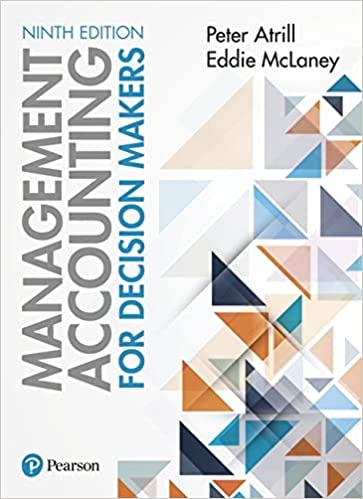Question
Company FINC is investigating the feasibility of introducing a new product to the market. Based on the market research, it forecasts unit sales as follows:
Company FINC is investigating the feasibility of introducing a new product to the market. Based on the market research, it forecasts unit sales as follows:
| Year | 1 | 2 | 3 | 4 | 5 | 6 | 7 | 8 |
| Unit Sales | 3,000 | 5,000 | 6,000 | 6,500 | 6,000 | 5,000 | 4,000 | 3,000 |
The new product will be priced to sell at $120 per unit to start, when the competition catches up after three years, FINC anticipates that the price will drop to $110.
The variable cost per unit is $60, and the total fixed costs are $25,000 per year. The new product will require $20,000 in net operating working capital at the start, which will be recovered at the end of the project.
This project will cost about $800,000 to buy the equipment necessary to begin production. This $800,000 will be 100% depreciated over the life of this project (8 years) as seven-year MARCS property. The depreciation schedule is shown as follows:
| Year | MARCS Depreciation Schedule (% of the equipments initial cost) |
| 1 | 14.29% |
| 2 | 24.49 |
| 3 | 17.49 |
| 4 | 12.49 |
| 5 | 8.93 |
| 6 | 8.92 |
| 7 | 8.93 |
| 8 | 4.46 |
The equipment will be worth 20% of its initial cost in 8 years, or the salvage value is $160,000 (=0.20 x $800,000). The tax rate is 21%, and the required return (WACC) on this project is 15%.
Questions:
What are the estimated cash flows of this project?
| Year | Estimated Total Cash Flows |
| 1 |
|
| 2 |
|
| 3 |
|
| 4 |
|
| 5 |
|
| 6 |
|
| 7 |
|
| 8 |
|
What is the NPV of this project?
What is the IRR of this project?
What is the Payback Period of this project?
| Year | Cumulative Cash Flows |
| 1 |
|
| 2 |
|
| 3 |
|
| 4 |
|
| 5 |
|
| 6 |
|
| 7 |
|
| 8 |
|
Based on above information, should FINC proceed? Why?
Estimation Procedures:
Table 1. Calculate Depreciation MACRS Schedule
| Year | MARCS Depreciation Schedule (% of the equipments initial cost) | Annual Depreciation |
| 1 | 14.29% |
|
| 2 | 24.49 |
|
| 3 | 17.49 |
|
| 4 | 12.49 |
|
| 5 | 8.93 |
|
| 6 | 8.92 |
|
| 7 | 8.93 |
|
| 8 | 4.46 |
|
Table 2. Calculate Operating Cash Flows Fill the estimated Income Statements
| 1 | 2 | 3 | 4 | 5 | 6 | 7 | 8 | |
| Unit Price | ||||||||
| Unit Sales | ||||||||
| Revenues | ||||||||
| Variable Costs | ||||||||
| Fixed Costs | ||||||||
| Depreciation | ||||||||
| EBIT | ||||||||
| Taxes (21%) | ||||||||
| EBIT (1 T) | ||||||||
| Depreciation | ||||||||
| EBIT (1 T) + DEP [OCF] |
Table 3. Calculate Initial Cash Outlay at Year 0
| CAPEX (Equipment cost) |
|
| DNOWC |
|
Table 4. Calculate Terminal Cash Flows at Year 8
| Salvage Value of Equipment |
|
| Tax on Salvage Value [Tax rate x (salvage value book value)] |
|
| After-Tax salvage value |
|
| DNOWC Recovered |
|
Table 5. Projected Cash Flows, FINC New Project
|
|
| Year | |||||||
| 0 | 1 | 2 | 3 | 4 | 5 | 6 | 7 | 8 | |
| OCF |
| ||||||||
| Capital Spending |
| ||||||||
| NOWC |
| ||||||||
| Total Projected CF |
| ||||||||
Step by Step Solution
There are 3 Steps involved in it
Step: 1

Get Instant Access to Expert-Tailored Solutions
See step-by-step solutions with expert insights and AI powered tools for academic success
Step: 2

Step: 3

Ace Your Homework with AI
Get the answers you need in no time with our AI-driven, step-by-step assistance
Get Started


